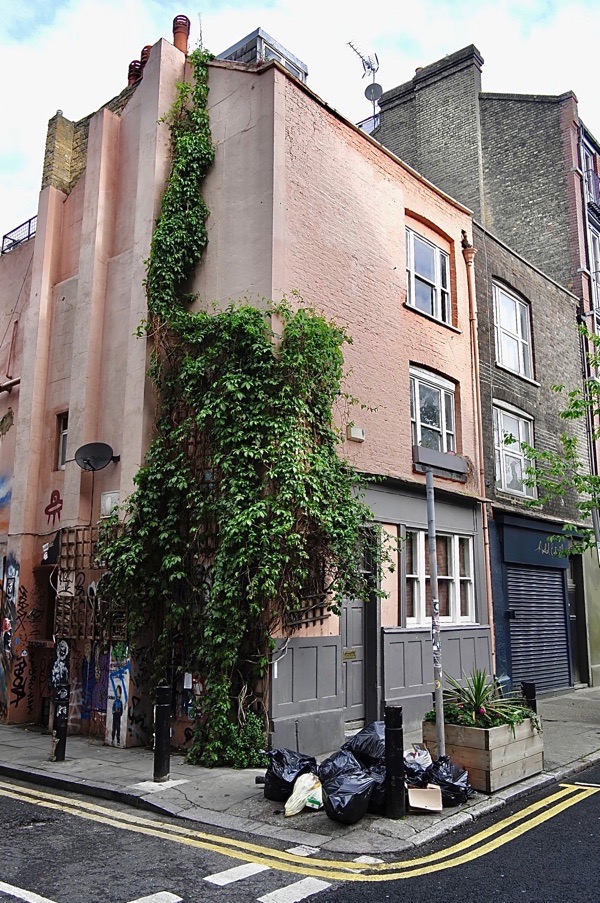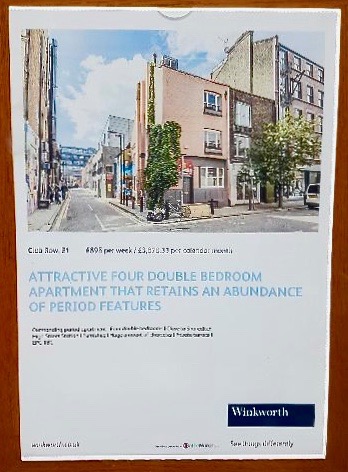A pair of weavers’ houses at 3-5 Club Row dating from 1764/66
I am overjoyed to announce that – thanks in no small part to the campaign waged by you the readers of Spitalfields Life - yesterday the Minister for Culture, Media & Sport announced that the pair of Journeyman Weavers Houses at 3/5 Club Row have been designated as Grade II listed by Historic England. This new protected status invalidates the owners’ current application for demolition and redevelopment.
You will recall that the owners sought to destroy 3 Club Row and replace it with a new building in generic spreadsheet architecture, claiming in their planning application that “3 Club Row has little architectural merit and partly due to the emergence of ever larger buildings surrounding it, doesn’t contribute to the appearance of the area.” and “The proposed replacement scheme will be of a suitably high quality that will enhance the Redchurch St Conservation Area.”
Yet when it came to realising the value of 3 Club Row as rental property, a different language was required. Simultaneously, the owners were advertising the building for rent with Winkworth Estate Agents in Shoreditch, who boasted of its “abundance of period features” as a selling point.
Credit is due to Tower Hamlets Planning Department who – in response to the huge number of letters of objection to the proposed demolition – issued a Building Preservation Notice to ensure the safety of 3 Club Row while Historic England made a survey and undertook the process of assessing the listing designation.
The significance of this pair of houses was outlined by Peter Guillery, Senior Historian at the Survey of London, in his definitive book The Small House in Eighteenth Century London. “In few, if any, other London districts would the provision of new housing have been so clearly and directly associated with the needs of a single industry,” he wrote. They were “a local solution to a local problem,” built specifically for journeymen silk weavers of Bethnal Green. These were the first buildings in London constructed specifically to fulfil the requirements of both living and working.
While the grand terraces of silk merchants’ houses in Spitalfields declare their history readily, these more modest buildings of the same era survive as the last vestiges of the workshops and dwellings where the journeyman weavers pursued their trade. You might easily walk past without even noticing these undemonstrative structures, standing disregarded like silent old men in the crowd.
The importance of this listing by Historic England is that it acknowledges these houses where the silk weavers worked are equally as significant as the mansions of the merchants who profited from their labour. We cherish them as part of our collective history.
There are still a few places left for the guided walk to learn more about the journeyman weavers and discover their surviving houses this Saturday 15th June hosted by Julian Woodford, author of The Boss of Bethnal Green (Click here for tickets)
“An abundance of period features” for £895 per week
Note the developer’s Porsche in this elevation of their proposed replacement building
3-5 Club Row, 1953
These houses were built between 1764 and 1766, specifically for the journeymen silk weavers of Bethnal Green and the related trades of silk throwsters, winders and dyers.
These are single depth, one-room-plan houses with a rear window, so light could permeate from front and back. The wide top-floor windows, built into the main body of the house rather than into the attics, were for maximum light, essential for colour-matching fine silk threads. The brick frontages allowed the construction of the staircases while the rear walls were often of wood.
They were constructed as multi-occupant, single-room, workshop-homes, with one family per floor and silk weaving at the top. A journeyman family could only afford one room and work dominated their lives, so no space was provided for much else, with the size of looms dictating the size of the rooms.
CLICK HERE TO READ HISTORIC ENGLAND’S FULL LISTING DESIGNATION
You may also like to read about



